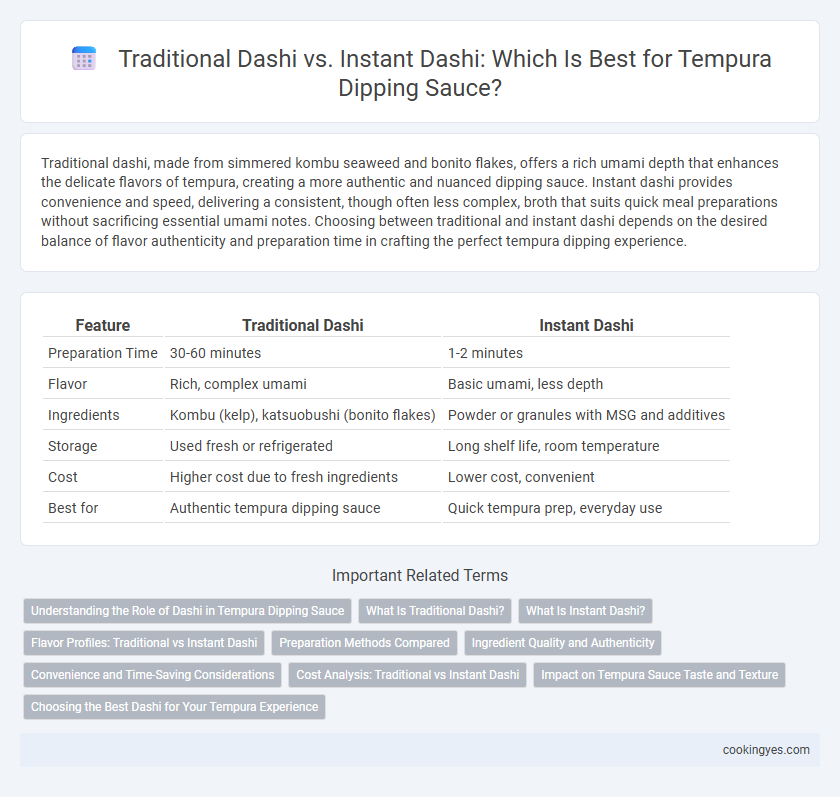Traditional dashi, made from simmered kombu seaweed and bonito flakes, offers a rich umami depth that enhances the delicate flavors of tempura, creating a more authentic and nuanced dipping sauce. Instant dashi provides convenience and speed, delivering a consistent, though often less complex, broth that suits quick meal preparations without sacrificing essential umami notes. Choosing between traditional and instant dashi depends on the desired balance of flavor authenticity and preparation time in crafting the perfect tempura dipping experience.
Table of Comparison
| Feature | Traditional Dashi | Instant Dashi |
|---|---|---|
| Preparation Time | 30-60 minutes | 1-2 minutes |
| Flavor | Rich, complex umami | Basic umami, less depth |
| Ingredients | Kombu (kelp), katsuobushi (bonito flakes) | Powder or granules with MSG and additives |
| Storage | Used fresh or refrigerated | Long shelf life, room temperature |
| Cost | Higher cost due to fresh ingredients | Lower cost, convenient |
| Best for | Authentic tempura dipping sauce | Quick tempura prep, everyday use |
Understanding the Role of Dashi in Tempura Dipping Sauce
Dashi is fundamental in tempura dipping sauce, providing a delicate umami base that enhances the dish's light, crispy texture. Traditional dashi, made from kombu and katsuobushi, offers a complex, rich flavor profile that balances the savory and subtle sweetness of tempura. Instant dashi provides convenience but often lacks the depth and nuanced taste essential for an authentic tempura experience.
What Is Traditional Dashi?
Traditional dashi is a fundamental Japanese broth made by simmering kombu (kelp) and katsuobushi (dried bonito flakes), providing a delicate umami flavor essential for authentic tempura dipping sauce. Its rich, natural taste results from the slow extraction of glutamates and inosinate, which enhances the subtle crispiness of tempura without overpowering it. Unlike instant dashi, traditional dashi offers a fresher, more complex profile that elevates the overall dining experience.
What Is Instant Dashi?
Instant dashi is a concentrated powder or granule made from dehydrated kombu, bonito flakes, and other umami-rich ingredients, designed to quickly replicate the flavor of traditional dashi broth. It offers a convenient and time-saving alternative for preparing tempura dipping sauce while maintaining the essential savory depth and aroma. Instant dashi dissolves easily in hot water, making it ideal for home cooks seeking authentic flavors without lengthy preparation.
Flavor Profiles: Traditional vs Instant Dashi
Traditional dashi offers a delicate umami richness derived from simmered kombu and bonito flakes, creating a deeply layered flavor that enhances tempura's crispness. Instant dashi, while convenient, often contains additives and a saltier profile, resulting in a less nuanced taste that can overpower the subtle tempura flavors. For authentic tempura dipping sauce, traditional dashi provides a balanced, savory depth that elevates the dish's overall sensory experience.
Preparation Methods Compared
Traditional dashi preparation for tempura dipping sauce involves simmering dried kombu and bonito flakes, producing a rich umami flavor through slow extraction. Instant dashi, made from powdered or granulated stock, offers a quick, convenient alternative without the extended simmering time but may lack depth and subtlety. The choice between these methods impacts the flavor complexity and authenticity of the tempura dipping experience.
Ingredient Quality and Authenticity
Traditional dashi for tempura dipping sauce is crafted from high-quality ingredients such as kombu seaweed and katsuobushi flakes, imparting a rich umami flavor and authentic depth that instant dashi powders cannot replicate. Instant dashi often contains additives, preservatives, and artificial flavor enhancers, which compromise the purity and nuanced taste essential to genuine tempura dishes. Using traditional dashi elevates the dipping sauce with superior ingredient integrity and an unmistakable authenticity cherished in Japanese cuisine.
Convenience and Time-Saving Considerations
Traditional dashi, made from kombu and bonito flakes, offers a rich umami flavor ideal for tempura dipping sauce but requires longer preparation time and careful simmering. Instant dashi provides a quick, convenient alternative that significantly reduces cooking time, making it suitable for busy kitchens or last-minute tempura servings. Choosing instant dashi enhances time efficiency while maintaining a satisfactory taste profile for tempura dipping.
Cost Analysis: Traditional vs Instant Dashi
Traditional dashi for tempura dipping sauce involves simmering kombu and bonito flakes, resulting in higher ingredient and labor costs but superior flavor complexity. Instant dashi offers a cost-effective alternative with minimal preparation time and lower overall expenses, though it may lack the nuanced umami profile of traditional stock. Evaluating these factors helps determine the best balance between budget constraints and authentic taste in tempura cuisine.
Impact on Tempura Sauce Taste and Texture
Traditional dashi, made from kombu and bonito flakes, imparts a rich umami flavor and subtle depth that enhances the delicate texture of tempura dipping sauce. Instant dashi offers convenience but often lacks the nuanced savory profile and smooth mouthfeel characteristic of freshly prepared dashi. The quality of dashi directly influences the balance of sweetness, saltiness, and umami, which defines the overall taste and texture of the tempura sauce.
Choosing the Best Dashi for Your Tempura Experience
Traditional dashi, made from kombu and bonito flakes, offers a rich umami depth that elevates the subtle flavors of tempura, creating a harmonious dipping sauce. Instant dashi provides convenience and consistent flavor but often lacks the complex aroma and freshness of homemade stock. Selecting the best dashi depends on prioritizing authentic taste versus ease of preparation for your tempura experience.
Traditional Dashi vs Instant Dashi for Tempura Dipping Sauce Infographic

 cookingyes.com
cookingyes.com